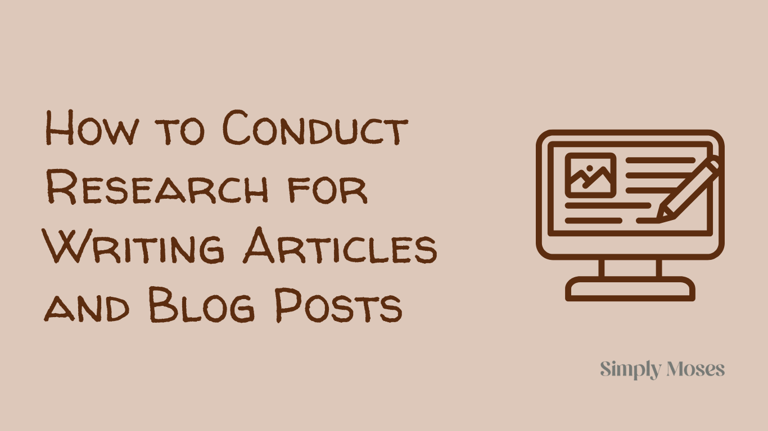🛑 Stop Guessing & Take Action Today!—Limited seats to ensure personalised attention! 👉 Learn More.
How to Conduct Research for Writing Articles and Blog Posts in 7 Steps (for Beginners)
Learn how to conduct research for writing articles and blog posts. Discover practical steps, tools, and where to find credible data.
By Moses Attamah
7/23/20253 min read


When done right, research takes your writing from average to exceptional.
If you’re struggling with how to do research and find credible data for content writing, this guide is for you.
How do you conduct research for writing step by step?
Here’s a simple, step-by-step guide to help you research effectively when writing articles or blog posts (with relatable examples and tips):
Understand what you’re writing about.
Know your audience.
Start with a quick search.
Use local sources where possible.
Take notes and organise your research.
Look for statistics or data.
Verify the accuracy of your data.
Step 1: Understand what you’re writing about.
Before searching on Google, ask yourself:
What is my topic?
What do I want to say about it?
What questions should my article or post answer?
Example:
You're writing a blog post titled “How to Dress Well on a Budget in Nigeria.”
Your article should answer questions like:
Where can someone buy affordable but stylish clothes?
What basic items should be in a wardrobe?
How can someone look good without spending too much?
Step 2: Know your audience.
To understand your audience, ask yourself:
Who am I writing for?
What do they need or want?
Example:
Your audience might be young Nigerian women, students, or NYSC corps members who want to dress nicely but don’t have much money.
Understanding your audience helps you know the kind of examples, language, and tone to use in your writing.
Step 3: Start with a quick search.
Go to Google or YouTube and type in your topic or question.
Example:
Search for related topics like:
“how to dress well in Nigeria on a budget”
“affordable fashion brands in Lagos”
“wardrobe essentials for Nigerian ladies”
This will depend on your specific audience.
Pro tip: Open 3–5 of the most useful articles or videos and scan them for ideas, tips, and data.
Step 4: Use local sources where possible.
International sources (websites and databases) may not always reflect the Nigerian reality.
So, find Nigerian sources for real-life examples.
Check:
Nigerian fashion websites and blogs like Style Rave, BellaNaija Style
Instagram pages of Nigerian stylists like Vikki James, Rhoda Ebun, and Medlin Boss
Market prices: Visit or ask someone about prices in Nigerian markets, or online shops like Jumia or Instagram thrift sellers.
See our guide on where to find reliable sources for research.
Subscribe to my newsletter!
Step 5: Take notes and organise your research.
As you research, write down important points, quotes, or stats you want to use.
Keep it neat so you don’t forget where you found what.
For this purpose, you can use:
Google Docs
Notebooks
Notes app on your phone.
Example:
“Ankara tops go for N3,000–N5,000 in Lagos Island market.”
“Zara-inspired shoes sold by thrift pages on Instagram cost around N6,000.”
Step 6: Look for statistics or data (if needed).
Adding numbers makes your article stronger.
Examples:
“According to a 2023 survey by XYZ, 60% of Nigerian youths buy thrift clothes.”
“Jumia reported that fashion items were the third most bought products during the June Black Friday sales.”
Sources to find statistics and data include:
Or trusted news sites.
See our guide on where to find reliable sources for research.
Step 7: Verify the accuracy of your data.
Before using your data, confirm whether it’s accurate.
Ask yourself:
Are these facts correct?
Is the website or person I got it from credible and trustworthy?
Did I mix up anything: dates, prices, names, or locations?
Answering these questions will ensure you’re not sharing false and misleading information with your audience.
Subscribe to my newsletter!
Tips for using your data
Here are 2 tips to guide your use of data:
1. Don’t steal someone else’s ideas.
Never steal or copy and paste ideas or data from other websites or writers.
Doing that is plagiarism, and this will ultimately undermine your credibility as a writer.
Instead, understand what the writer is saying and write it in your own words, using your own examples.
Example:
Instead of copying: “Wear neutral tones for timeless style.”
You can write: “Colours like black and white never go out of style. Every Nigerian girl should have at least one of these shades in her wardrobe.”
Finally, remember to cite your sources appropriately.
Meanwhile, know when to cite and when not to cite sources.
2. Add personal or local examples.
Make your content feel real and relatable.
This depends on your audience.
If your readers are Nigerians, you must have them in mind when sharing your examples.
For instance:
“Instead of buying new jeans for N15,000, check Instagram thrift pages like @thriftsure_ng. You’ll find good jeans for N3,500.”
With personal or local examples like this, your article or blog post becomes relatable and helpful to your Nigerian readers.
Bottom line
When you do research well, it takes your writing from average to exceptional.
Following the steps outlined in this guide will enhance the quality of your writing, whether you’re writing an article or a blog post.
